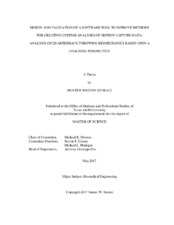| dc.description.abstract | The goal of this work was to develop a software platform to synchronize and facilitate the way in which researchers perform custom analysis of motion capture (MOCAP) data. The software was developed using Python and contains both frontend and backend tools to accomplish this goal. It includes a user interface which allows users to: access MOCAP trial data, view corresponding video files, display results of custom-programmed analyses, bulk analyze data, compile and save results, and generate PDF reports over the analysis. The backend contains a set of tools which: allow for easy access of MOCAP data stored in the C3D file format, establish a framework which future custom MOCAP analysis can follow, and efficiently stores results in a platform-independent, serialized, data file which can be opened at a later time for additional statistical processing of results.
To validate the software platform a human subjects research study was designed to analyze quarterback (QB) throwing biomechanics in a manner consistent with what football coaches are teaching to players. Interviews were conducted with eight coaches from the middle school and high school levels to establish the common “coaching points” being taught to players. A custom marker-set was designed for the study, and fifteen QBs (ages 12-18, mean 15.1) were brought in for data capture. Subjects were asked to perform three throws (hitch, corner, comeback), each using a different foot pattern (quick game, 3-step drop, rollout), to each side of the field. Throwing data was captured using a twelve-camera Vicon Motion Capture System (Vantage V16), and four AMTI force plates (OR6-6-1000). Custom analyses were programmed to examine the coaching points from the interviews: elbow flexion, balance throughout the throwing motion, release time, release orientation, analysis of the stride, accuracy of the throw, and the hip leading angle were the points of interest. Additional analyses, from both the QB work and a separate MOCAP study, were programmed by undergraduate researchers in the lab, to verify the use of the software’s usefulness to multiple users and applications. | en |


